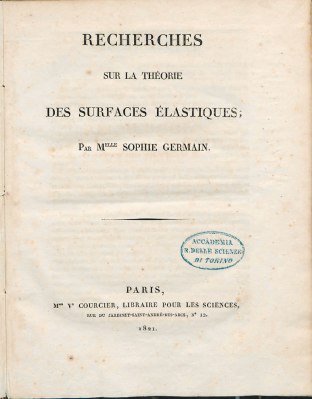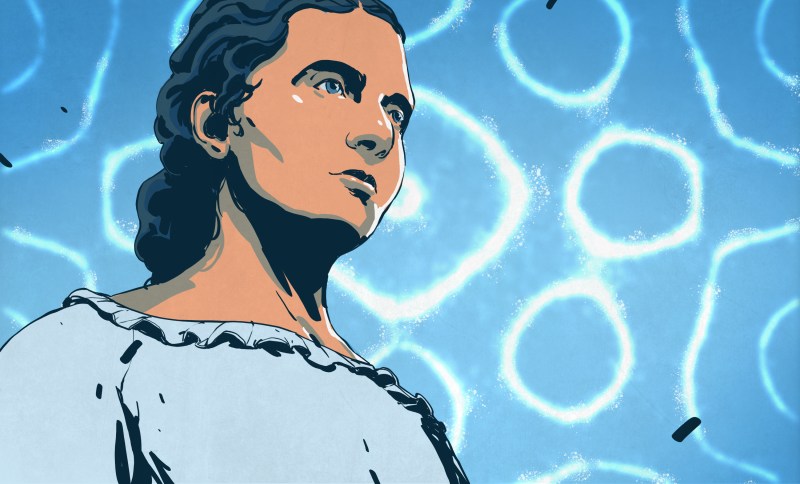When a 13-year old Marie-Sophie Germain was stuck in the house because of the chaotic revolution on the streets of Paris in 1789, she found a refuge for her active mind: her father’s mathematics books. These inspired her to embark on pioneering a new branch of mathematics that focussed on modeling the real world: applied mathematics.
Post-revolutionary France was not an easy place for a woman to study mathematics, though. She taught herself higher maths from her father’s books, eventually persuading her parents to support her unusual career choice and getting her a tutor. After she had learned all she could, she looked at studying at the new École Polytechnique. Founded after the revolution as a military and engineering school to focus on practical science, this school did not admit women.
Anyone could ask for copies of the lecture notes, however, and students submitted their observations in writing. Germain got the notes and submitted her coursework under the pseudonym Monsieur Antoine-August Le Blanc. One of the lecturers that she impressed was Joseph Louis Lagrange, the mathematician famous for defining the mathematics of orbital motion that explained why the moon kept the same face to the earth. Lagrange arranged to meet this promising student and was surprised when Germain turned out to be a woman.
Gauss and Germain
‘Le Blanc’ also corresponded with German mathematician Carl Friedrich Gauss on number theory. When Napoleon’s armies occupied the town the famous mathematician lived in, Germain enlisted a family friend in the army to check that Gauss had not been harmed. Gauss didn’t realize who had helped him out, until he discovered that ‘Le Blanc’ was Sophie Germain, he wrote to her thanking her for her concern and praising her mathematical prowess given the hurdles set before her.
“How sweet is the acquisition of a friendship so flattering and precious to my heart. The lively interest you took during this terrible war deserves the most sincere recognition….But when a person of this sex, who, for our mores and prejudices, must recognize infinitely more obstacles and difficulties than men to become acquainted with these thorny searches, knows how to get rid of these obstacles and to penetrate what they have, most hidden, must undoubtedly, she has the most noble courage, talents quite extraordinary, genius superior.”
As well as working on the thorny and theoretical problems of number theory, Germain worked on applying mathematics to real world problems. One of these was a challenge set by the Paris Academy of Science to mathematically describe the elasticity of metal plates. An experimenter called Ernest Chladni had demonstrated that a metal plate would resonate in odd ways when vibrated at certain frequencies. If you put sand on the plate, it would collect in different patterns created by the resonance of the plate, called Chladni figures. To win the prize, the solution had to predict these figures.
The Mathematics of Stress and Strain
Mathematically predicting the behavior of metal plates could make it easier to design metal objects and predict how they would behave under stress. The prize was set in 1808 but was so difficult that Germain was the only one who decided to try to solve it, as it required coming up with a whole new way to analyze and describe how materials bend and change under stress.
 The first two solutions that she submitted were rejected due to mathematical errors, but the third version won her the prize in 1816. However, due to the Academy policy of not allowing women to join (and to only attend events if they were wives of members), Germain was not able to attend the ceremony where the prize was granted. She was also not allowed to attend meetings of the Academy. After the Academy failed to publish her prize-winning work, Germain had to pay to publish the work herself in 1821.
The first two solutions that she submitted were rejected due to mathematical errors, but the third version won her the prize in 1816. However, due to the Academy policy of not allowing women to join (and to only attend events if they were wives of members), Germain was not able to attend the ceremony where the prize was granted. She was also not allowed to attend meetings of the Academy. After the Academy failed to publish her prize-winning work, Germain had to pay to publish the work herself in 1821.
Later, her friend Joseph Fourier allowed her to attend meetings and presentations, but the mathematical establishment never really accepted her, or her work. In a letter to a colleague in 1826 she complained about the way they rebuffed her:
“These facts are my domain and it is to me alone that they remain hidden. That’s the privilege of the ladies: they get compliments and no real benefits.”
In the same letter, Germain complained of suffering fatigue and she was diagnosed with breast cancer shortly afterwards. She died in 1831. Her final years were spent working on a solution to Fermat’s Last Theorem, and just before her death she published a partial solution that was the basis for much research into the theorem, which was finally solved only with computer help in the late 1990s.
Although Sophie Germain never earned a degree in her lifetime, she was given an honorary degree in 1837 from the University of Göttingen at the suggestion of Gauss, who noted that
“she proved to the world that even a woman can accomplish something worthwhile in the most rigorous and abstract of the sciences and for that reason would well have deserved an honorary degree.”
The Academy that snubbed her also now offers an annual prize for mathematics in her name. Perhaps more importantly, her work formed the basis of the study of elasticity and stress in metals that allowed engineers to build larger objects and buildings. Creations such as the Eiffel tower in 1887 were directly influenced by her work, and it laid some of the groundwork for Einstein’s theory of General Relativity.
Modern scholars argue that Germain could have been more than she was: her work, they argue, was hamstrung by a limited understanding of some of the fundamental concepts that Gauss and others had described. Although her work was fundamental and important, if she had been given free access to the education that she wanted and deserved, it’s easy to imagine that she would have gone farther.
















“She taught herself higher maths from her father’s books, eventually persuading her parents to support her unusual career choice and getting her a tutor.”
Certainly a harder way to learn. With tutor is better.
There is at least one error in this article: computers had nothing to do with Andrew Wiles’s proof of Fermat’s Last Theorem.
Fixed. The remaining errors are left as an exercise for the determined reader.
And it was not “solved”, it was proven.
She studied her father’s books in 1789 at the age of thirteen, and paid to have her book published in 1921.
Wow! 145 years old!
B^)
Oh wait, you said she died in 1831…
And the link doesn’t even work. Session expired.
Benji, thanks for pointing out the problem with that link: I replaced it with a link to the Google Books version.
Thanks for pointing out the typo: fixed.
“a solution to Fermat’s Last Theorem, and just before her death she published a partial solution that was the basis for much research into the theorem, which was finally solved only with computer help in the late 1990s.”
Did I miss something? Wiles’s proof wasn’t solved with computer help, and it was in the early 1990s (technically 1995).
Serious bit fixed in the article.
But we’ll stand by 1990-94 being early 90’s, and 1995-1999 being the late 90’s. Maybe we should have gone with “mid”?
I’ve always gone with groups of 3’s for early, mid, and late. IOW, last digit 1–3 for early, 4–6 for mid, and 7–9 for late. For instance, if someone’s 27, then he’s in his late 20’s and 1985 is mid 80’s.
FWIW.
What about when you’re 20?
For me, the mid-30’s stretched on until at least 38…
When you’re 20, you’re just 20. (c:
Yah, sure they are.
There were certainly more men than women in my computer science classes however the female half of our species certainly was represented. And yet… I never witnessed any professors or other students being anything but respectful towards them. And in my math classes the professors were just as likely to be women as men.
But.. I am a man… so maybe I just didn’t see it.
So… I asked my wife. She put in 5 years, first towards an Electrical Engineering degree then part way through she switched to medical for reasons completely unrelated to her gender.
She said she was hounded constantly by amorous male students that were imported from a certain region of Asia that I will leave it to the reader to guess. Besides from that she said everyone else was just fine towards her.
I realize that this is just two people’s anecdotal experience but come on. Here in the western world it is drilled into us by the media and by our schools from birth to death that we should treat people equally. Unless.. we listen to the people that want to slide things to the opposite extreme ostensibly to right some historic wrong. I just don’t see how any pockets of marginalization could survive today, at least outside of that one region.
Was an All-Female Construction Company Responsible for the FIU-Sweetwater Bridge Collapse?
Happens more often that we think. I know, if confronted, whoever wrote that article and others like him probably claim it’s just a joke or “satire”.
BTW, the Gauss dude’s got one h*ck of a neat handwriting. (c:
They talk funny back then. :-p
you want to be treated equally, fairly or the same
As a woman with several degrees, I’ve seen more over the top self-righteous attempts at correcting history (like these women-only HaD blurbs and Mods deleting comments implying that behavior is counterproductive) than actual overt sexism.
The only time I’ve ever felt treated differently because of my sex in the workplace was during our pre-grad interviews. Intel, Westinghouse, Schlumberger, IBM, etc all offered jobs to 100% of the graduating females and fewer than 15% of the males. It was so insulting as a woman to not even be asked a single technical question and know I’m going to get a job offer.
Just my experience.
Positive discrimination doesn’t exist. Discrimination is just that. Advantaging a woman because of her gender seems to be about the most belittling thing one can do.
I have to agree. Which is why I cringe when I see these HaD bio features.
This article includes several ignorant statements (far fewer than some comments) but the most ridiculous is that she pioneered applied mathematical modeling. Even Newton felt he didn’t do that and he developed calculus to model the real world!
Don’t virtue signal any harder beta boy you might explode.
Even if not perfect, these brief bio-articles are both interesting and stimulating – and I enjoy the ensuing banter. Philip (kindly old pedantic physicist/applied mathematician)
Yeah..exploring the world on your own is :)